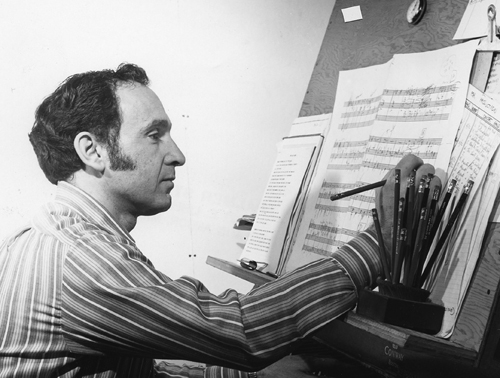
Often recognized as one of the 100 most popular marches in the band repertoire, Block M Concert March for Band by Jerry H. Bilik (Alfred) continues to bring sincere delight to band members and audiences. The Block M is the symbol for the Michigan monogram and was written for the University of Michigan Band’s annual Variety Night concert while the young composer was still an undergraduate student there. It became Bilik’s first published work in 1955 as he began an extremely prolific career that has spanned into the 21st century.
Born in New Rochelle, New York, on October 7, 1933, Jerry Bilik attended the Interlochen Center Music Camp as a high school student before completing both his BME and MM degrees at the University of Michigan in Ann Arbor. He credits Tibor Serly, former student and apprentice of Bela Bartok, as his most influential composition teacher. A “17th trombonist”1 as he describes his freshman year position in the University of Michigan marching band, he found a niche as a composer and arranger, first serving in the latter category with the West Point Military Academy Band before returning to Michigan to join the composition faculty and later teaching at Wayne State University. Along with works for chamber ensembles, orchestra, and choir, his other compositions for band include American Civil War Fantasy, Concertino for Alto Saxophone and Band, American Variations, Symphony for Band, Rhapsody on Russian Folksongs, and the M Fanfare performed regularly at athletic events at Michigan.
He has been chief arranger for the Emmy and Academy Awards programs, the Ringling Brothers’ Barnum & Bailey Circus, and 35 ice shows including the Wizard of Oz On Ice and Disney On Ice. He served as arranger for television shows including Starsky and Hutch and the original Charlie’s Angels and also did arranging for such movies as Vegas Vacation and My Side of the Mountain. During his career, he worked with Harry Connick, Jr., Johnny Carson, Danny Kaye, Dick Van Dyke, Neil Diamond, Bobby McFerrin, Barbra Streisand, Siegfried & Roy, and Leonard Bernstein.
At a difficulty level of 3-4, this 141-measure gem in Bb begins with an eight-measure introduction, followed by a first strain, second strain, modulation to Eb at the trio, and fight strain or “dog fight,” before concluding with a standard trio recapitulation. At the suggested tempo of half note = 152 and set in cut time or alla breve, the composer suggests a duration of 3:30. The instrumentation is also standard but includes parts for Eb clarinet and string bass.
Four players will be needed to cover the percussion parts which consist of four timpani (tuned to F, Bb, C, Eb), snare drum, crash cymbals, and bass drum. The snare drum should be played with medium-weight sticks, preferably with wooden tips; this allows the part to be heard without sounding too thin or too heavy. Avoid using skinny drumset sticks, which lack the depth of tone required for most concert band or orchestral playing. Also avoid marching sticks, which are simply too heavy when performing an indoor concert march. Be sure to tune the bass drum so that it has some resonance, unlike the tight sound often preferred for marching.
A common misconception in percussion performance is that the timpanist should use hard sticks whenever the dynamic in any piece is forte or louder. Hard felt timpani sticks, sometimes referred to as staccato mallets, are intended for passages where rapid, precise articulation is required and not simply for more volume. As a general rule, the harder the mallets, the less body or fullness of tone is produced. For this march, it is recommended that medium mallets be used from beginning to end. When the volume reaches fortissimo, simply ask the timpanist to stroke the timpani from a higher level to achieve the required louder dynamic without sacrificing the much preferred full-bodied tone quality.
The standard ternary (ABC) form of this classic march lends itself to an exceptional educational opportunity for the innovative band director. To begin to instruct your students about basic march form, take five minutes of an early rehearsal and explain the principal sections of the work. Then have students write into their individual parts where each of those sections begins:
Introduction: measure 1
First Strain: measure 9 (A)
Second Strain: measure 43 (B)
Trio: measure 60 (C)
Fight Strain: measure 94 (D)
Trio Recapitulation: measure 110 (E)
Then in the ensuing rehearsals, make a practice of referring to the passages being addressed and drilled by their structural name rather than by just a rehearsal letter or number. Your script might go something like this.
“Our tempo is slowing during the trio section. Let’s start at the beginning of the trio.” “Percussion, be sure to make your entrance prominent at the measure before the Fight Strain. Let’s begin right there.” Almost effortlessly, the students will become familiar and comfortable with these important formal sections of a standard march simply by addressing these sections in rehearsals as if students were professional musicians.
Rehearsal and performance challenges begin with the determination of a suitable tempo. The composer suggested tempo of half note = 152 can be a bit brisk rhythmically in the opening measures when performed by double-tonguing cornets and trumpets in unison with single-tonguing woodwinds. If these players are still in a developmental stage, some slight compromise may be necessary to make the introduction sound clean, separated, and energetic. All musicians should observe the sudden mf in measure 8 to make an effective transition into the first strain. On the repeat of the same strain, the dynamic drops from mf to p.
At 43 (the second strain) the low brass, horns, and bassoons should rise to a controlled ff level while the remaining woodwinds and cornets return to mf. All woodwind trills beginning in the second strain and continuing throughout the march should have sizzle and enthusiasm. I suggest instructing these musicians to begin each with an accent, trill rapidly, and even perform a slight crescendo through each one.
The trio at 60 introduces a traditional modulation up a perfect fourth to Eb, a dynamic drop to pp and a more legato style, both of which traditionally result in an unintended slowing of the tempo. Address this tendency during the first reading of the march to begin to teach players about this unacceptable diminution of pulse. In my article “The Art of Guest Conducting” from the February 2005 issue of The Instrumentalist, it is stated that addressing steady internal pulse is one of the initial items Frank Battisti attacks when conducting an honor band.2 Techniques for developing this steady internal pulse include using a loud metronome while students play, having students sing their parts while a quieter metronome clicks the required steady tempo, and simply stepping away from the podium. These should be used right from the first rehearsal to encourage students to keep the trio tempo steady.
An interesting phenomenon frequently happens in an early rehearsal at the first ending of the trio. The cornet and trumpet sections, which have been resting for 30 measures, often miss their important first ending entrance. Prior to the initial reading, remind them to switch to cup mutes during the opening of the trio and to count carefully so that their prominent entrance is solid and convincing.
Although the percussion part suggests an optional snare drum part played with brushes at the trio, many conductors opt to leave this out entirely with the snare drum (using sticks), bass drum, and timpani introducing the fight strain at 93 at a decidedly ff level.
An interpretive suggestion for the performance of the trio and trio recapitulation is to add a two-measure crescendo followed by a two-measure diminuendo when playing the whole notes in the first four measures of the new trio theme and whenever it is repeated thereafter. However, the quarter- and eighth-note rhythms that follow should be separated even throughout the trio. Further note that the dynamic increases to mf following the first ending, but the addition of the cornets will probably assist with that step-up in dynamic level.
For a refreshing twist to the performance of this classic march, consider placing a sudden and abrupt grand pause after the first beat of measure 108. Then place a fermata over each of the following three half notes. The last fermata should be played a bit longer than the first two and might include a slight crescendo. You can ask the timpanist to add a roll to that final half note, as well. Then, on the downbeat of measure 110, return to the original tempo. Perhaps this sounds like a splash of Hollywood, but it can prove extremely effective and add a bit of suspense and excitement to a performance. Considering Jerry Bilik’s heralded career in show business, it could be said that this modification stays true his style of arranging.
The trio recapitulation begins at a dynamic level of fff. Caution students (especially the salivating trombonists) not to overdo this enticing marking but to maintain a controlled and well-blended sound even at this stronger dynamic level. As your performance reaches the climactic stinger, consider changing the final quarter in the snare drum to a flam or a single-stroked four-stroke ruff. This will match and enhance the grace notes in the upper woodwinds.
Errata
Measure 43: The percussion part should have mf added.
Measure 60: In the score and 2nd and 3rd clarinet parts, change the dynamic from mp-mf to pp-mf to match the first clarinet.
Measure 60: In the 1st and 2nd horn parts, change mp-f to mp-mf.
Measure 60: In the score, add “optional snare drum with brushes” (original Belwin edition only).
Measure 87: Consider adding accents over both half notes in all horn parts to match bassoon, basses, and string bass.
Measure 93: In the score and snare drum parts add “with sticks.”
Measure 137: Consider adding accents to both half notes in the piccolo, flute, oboe, Eb clarinet, Bb clarinet, alto clarinet, alto sax, tenor sax, baritone sax, cornet, trumpet, horn, trombone, baritone, cymbal, and bass drum parts to match the bassoon, bass clarinet, bass, string bass, and snare drum parts.
Endnotes
1“Scenes from An Interview: Jerry Bilik” by Gus Mollasis. Scene (Sarasota) Magazine, September, 2013, page 48.
2“The Art of Guest Conducting” by Gary Stith. The Instrumentalist, February 2005, page 15.
3“Scenes from An Interview: Jerry Bilik” by Gus Mollasis.





